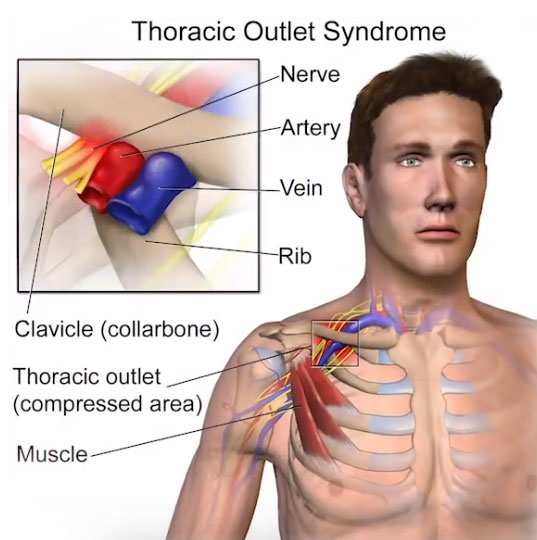Thoracic Outlet Syndrome (TOS)
Thoracic Outlet Syndrome (TOS) occurs when nerves, arteries or veins are impinged in the space over your first rib or thoracic outlet.
- Arterial TOS, the rarest form, usually manifests as a clot originating in the subclavian artery which travels to the arteries of the forearm or hand. These clots can block blood flow causing the loss of pulse in the wrist, which can result in pain, discoloration and even limb loss.
- Venous TOS, occurs when the subclavian vein in the shoulder is pinched by abnormally tight muscles which attach to the first rib. This pinch can cause clots to form in the vein which causes abnormal swelling of the arm often during or after a strenuous workout.
- Neurogenic TOS, the most common thoracic outlet syndrome, is caused by an impingement or compression of the nerves to the arm (also called the brachial plexus). Neurogenic TOS typically occurs in the third through fifth decade of life and may follow a motor vehicle accident, fall or repetitive work. Symptoms of numbness and tingling of the arm, forearm and some or all fingers often start intermittently and progress to constant discomfort or pain.

Signs and Symptoms
- Pain, numbness or tingling in the arm, forearm or fingers
- Loss of pulse in the wrist
- Swollen, bluish arm
- Clumsiness of the affected arm
- Band-like tightness around the bicep muscle
- Cold hand or arm
- Waking during the night with pain, aching or numbness of the arm
- Headaches, neck pain, shoulder and back muscle tightness or chest discomfort
Risk Factors
- Injuries such as a motor vehicle accident or a fall
- Repetitive overhead activity
- Sometimes may occur without obvious cause
Detection
Besides a detailed history and physician examination, your provider may request additional tests including x-rays or duplex ultrasound of the neck, chest and shoulder, scans of the neck brachial plexus or shoulder, electro diagnostic studies of the arm and diagnostic blocks of the plexus or the scalene muscle.
Treatment Options
For each type of problem- venous, arterial or nerve impingement- there are both non-surgical and surgical options.
- Arterial TOS
- When the subclavian artery has been injured by the bony and non-bony structures at the thoracic outlet, the best treatment is surgery.
- Venous TOS
- When a clot forms in the vein, swelling can be treated with compression sleeves and blood thinners to prevent more clots from forming. If the clot is found early enough, some patients may be candidates for lysis, or removal of the clot with clot busting drugs.
- Neurogenic TOS
- Pain from impingement of the brachial plexus may be treated through a variety of options including physical and occupational therapy, massage by trained therapists, nerve stimulator to block the pain messages from the arm, and medicines to aid
in sleep, reducing swelling and pain and treating depression. Other methods include biofeedback, acupuncture, meditation, chiropractic care, yoga, Pilates and other therapies. If these therapies fail after 12 weeks and the symptoms are intolerable,
surgical decompression of the brachial plexus may become a reasonable option.
- Pain from impingement of the brachial plexus may be treated through a variety of options including physical and occupational therapy, massage by trained therapists, nerve stimulator to block the pain messages from the arm, and medicines to aid
in sleep, reducing swelling and pain and treating depression. Other methods include biofeedback, acupuncture, meditation, chiropractic care, yoga, Pilates and other therapies. If these therapies fail after 12 weeks and the symptoms are intolerable,
surgical decompression of the brachial plexus may become a reasonable option.
Call To Schedule An Appointment
303-539-0736